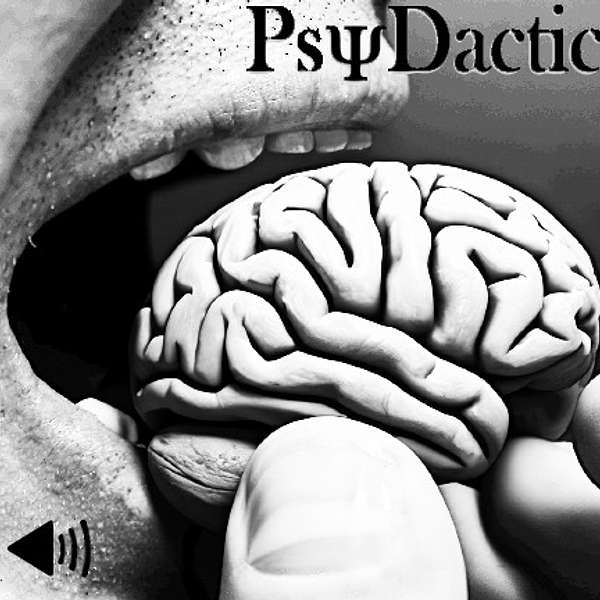
PsyDactic
A resource for psychiatrists and other medical or behavioral health professionals interested in exploring the neuroscientific basis of psychiatric disorders, psychopharmacology, neuromodulation, and other psychiatric interventions, as well as discussions of pseudoscience, Bayesian reasoning, ethics, the history of psychiatry, and human psychology in general.
This podcast is not medical advice. It strives to be science communication. Dr. O'Leary is a skeptical thinker who often questions what we think we know. He hopes to open more conversations about what we don't know we don't know.
Find transcripts with show-notes and references on each episodes dedicated page at psydactic.buzzsprout.com.
You can leave feedback at https://www.psydactic.com.
The visual companions, when available, can be found at https://youtube.com/@PsyDactic.
PsyDactic
The Noradrenergic Paradox
One of the most influential models in psychiatry’s history for understanding brain dysfunction is the monoamine hypothesis. In short, it proposes that deficiencies or excess of certain neuromodulating agents, in particular the monoamines serotonin, dopamine, and norepinephrine (AKA noradrenaline) drive many psychiatric disorders. The paper I will primarily reference is a publication by the same name in 2016 by Montoya, Bruins, Katzman, and Blier in Neuropsychiatric Disease and Treatment. Its basic proposal is that, at the time of publication, there were at least 52 controlled clinical trials published that consistently showed a benefit of using SNRIs (like venlafaxine and duloxetine) and NERIs (like atomoxetine and reboxitine) for reducing anxiety in patients without the expected side effect of noradrenergic agents: to increase anxiety. This is a paradox.
Please leave feedback at https://www.psydactic.com or send any comments to feedback@psydactic.com.
References and readings (when available) are posted at the end of each episode transcript, located at psydactic.buzzsprout.com. All opinions expressed in this podcast are exclusively those of the person speaking and should not be confused with the opinions of anyone else. We reserve the right to be wrong. Nothing in this podcast should be treated as individual medical advice.
Welcome to PsyDactic Residency Edition. I am Doctor O’Leary a third year psychiatry resident in the national capital region. I am excited to bring you another episode, and it is one that I really enjoyed making. If anything, this podcast is a public admission of my ignorance. I struggle to understand psychiatry. I question diagnoses. I question treatments. I offer my opinion. But my opinion is simply one that is forming. It is one that is incomplete. I hope if you struggle with me, that we can both come to a better understanding of what we do as psychiatrists. I represent no other institution, and these opinions are my own. They are not medical advice. At best they are educated ramblings.
If you have heard my previous episodes, you know I love a good story about the neuroscience of our interventions. I think it is the future of psychiatry. Anyone can conduct efficacy trials, but few can understand why something works “on average” for a certain condition, or why there are particular side effects of each treatment.
One of the most influential models in psychiatry’s history for understanding brain dysfunction is the monoamine hypothesis. In short, it proposes that deficiencies or excess of certain neuromodulating agents, in particular the monoamines serotonin, dopamine, and norepinephrine (AKA noradrenaline) drive many psychiatric disorders. Depression has been conceptualized as a deficiency of serotonin, anxiety as an excess of norepinephrine, and schizophrenia and mania as an excess of dopamine. But we know now that this conceptual framework is deficient in knowledge and excessive in clinical practice. However, it has borne fruit in that now we have many different agents to modulate neuronal activity. We have MAOIs, SSRIs, SNRIs, NERIs, dopamine blockers, alpha blockers, beta blockers and numerous other hard to classify agents like trazodone, clozapine, quetiapine, lurazadone, mirtazapine etc. There are lots of -ones, -dols, and -ines populating our pharmaceutical arsenals.
One problem we face is that we don’t have a mature concept of how networks of neurons are affected by these agents over time and why side effects abound amongst our agents. What I want to discuss today is a perfect example of this: The Noradrenergic Paradox. The paper I will primarily reference is a publication by the same name in 2016 by Montoya, Bruins, Katzman, and Blier in Neuropsychiatric Disease and Treatment. Its basic proposal is that, at the time of publication, there were at least 52 controlled clinical trials published that consistently showed a benefit of using SNRIs (like venlafaxine and duloxetine) and NERIs (like atomoxetine and reboxitine) for reducing anxiety in patients without the expected side effect of noradrenergic agents: to increase anxiety. This is a paradox. This paper was not a meta-analysis, but it demonstrated profoundly that simple predictions relying on the standard view of what would happen if we increase norepinephrine's presence in synapses is not sufficient.
I should start with the question, why do we expect NE to increase anxiety? We know that if you simply inject NE (AKA adrenaline) into a person their blood pressure will increase, they may breath faster, their muscles will engorge with blood, and they can get jittery and even feel an impending sense of doom. We know NE plays a crucial role in the sympathetic nervous systems response to threats. It is an integral player in the flight, fight, or freeze response. In some degree it participates in the hypervigilance and intense reactions to reminders of trauma in PTSD.
So, why, oh why would giving a compound that blocks the reuptake of NE at the terminal actually help with anxiety and PTSD and even ADHD?
Let's back up and have a look at the brain. Maybe you remember the locus coeruleus. It lives in the pons and produces NE. It is especially important for shipping NE to the hippocampus, the neocortex, and the cerebellum, which can help the brain pay attention, take notes, and prepare to move. More basically, it is part of the reticular activating system which tells the brain that it needs to start being conscious. There are other nuclei in the pons and the tegmental area that also produce and ship NE. The A5 and A7 nuclei in the pons join with the LC to deliver NE to the hypothalamus and the amygdala. Autonomic functions in the medulla and other parts of the midbrain rely on NE projections. NE is also shipped off to the spinal cord and helps regulate the response to pain, explaining why duloxetine is so frequently prescribed in chronic pain disorders. The LC is crucial for fear responses and stress and when it gets really active the result is anxiety.
That’s why it doesn’t seem to make sense that inhibiting the reuptake of NE would dampen down anxiety. The answer seems to have something to do with how NE is delivered for normal anxiety provoking situations, when fear and hypervigilance is needed. Animal studies have shown that the LC, the amygdala, and the hypothalamus get a relative flood of NE in stressful situations. Nuclei in the hypothalamus activate the hypothalamic-pituitary-adrenal or HPA axis, and this induces a whole body stress response as well as a ramping up of the LC, which makes the organism appear stressed and anxious.
The prefrontal cortex then comes into play. A little extra NE promotes cognition and executive functioning. Pay attention, look for important details, make decisions. Too little NE and we lose interest and get drowsy. Too much, and the system malfunctions, our working memory is impaired, and we go into survival mode. This is why people function poorly with little stimulation and poorly with too much. There is a sweat spot. It can also help explain why PTSD results in so much cognitive impairment. It is post synaptic alpha-1 and beta receptors in the PFC that are activated by NE and elicit a response. But things aren’t that simple.
The release of NE is also modulated by the presence of other monoamines, such as serotonin and dopamine. Plus, there are presynaptic alpha-2 receptors that are activated, resulting in reuptake of NE. Things get complex because changes in the relative concentration of any of these neurotransmitters can affect that presence of others and this may be different in different regions of the brain. As for the receptors, as far as we know, all of the alpha-2 receptors result in an inhibitory signal on the presynaptic neuron. Alpha-1 is usually excitatory, but may also be inhibitory. The odd numbered beta receptors (1 and 3) are excitatory, but beta-2 may or may not be. NE hits them all.
We have two commonly used alpha modulators prazosin and clonidine. Prazosin is an alpha-1 blocker, and clonidine is an alpha-2 agonist. They both end up having the effect of reducing the action of NE on neurons and can low blood pressure and reduce some anxiety responses (like nightmares and panic). I remember this by remembering prazosin is post and clonidine cleans up. Prazosin blocks postsynaptic alpha-1 and clonidine promotes clearing of NE by stimulating presynaptic alpha-2. It’s actually more complicated because there can also be postsynaptic alpha-2 receptors that have inhibitory effects.
The rub here is the relative affinity of the receptors. Alpha-2 has higher affinity than alpha-1 or beta receptors, which means that low levels of NE will first fill sites on receptors that have an overall dampening effect, while high levels promote activity. Prolonged high levels of NE will desensitize presynaptic alpha-2, but not the postsynaptic ones, showing that there can be adaptation that still preserves inhibitory responses. We don’t know all of these adaptions, but we know that SNRIs when they are titrated slowly serve more to reduce anxiety than to promote it.
Overall, what this means is that at baseline, normal function requires a certain tonic level of NE to promote cognition, while stress responses occur because of a phasic or pulsing type release of excess NE. One might think that people with PTSD and panic disorders would have increased basal rates of NE, but the authors report that this is not the case. Their levels are normal. However, they have exaggerated responses to phasic release of NE, and SNRIs, especially venlafaxine, have been demonstrated to be beneficial for these patients. Somehow, SNRIs reduce the hyper-responsiveness to this phasic release. Also, depression often results in cognitive decline and impaired awareness that often responds to treatment with SNRIs, suggesting there may be a relative depletion of NE in many of these patients that is corrected by the use of SNRIs.
The take-home message from this paper is that a simple view relying on assumptions that gently increasing baseline NE over time will increase anxiety or panic has not been demonstrated. In fact, the opposite has, and this is most likely due to complex adaptation of neurons to increased tonic levels of NE at the terminals that results in improved cognition and reduced hyper-responsiveness to phasic release of NE. This is the noradrenergic paradox.
Thank you for listening. I hope to be able to release another series soon that does a more deep dive into psychiatric treatments. I am excited to keep this podcast going as it forces me to organize my thoughts in a way that the distractions of clinical work and lectures simply cannot.
I am Dr. O, and this has been an episode of PsyDactic residency edition.



